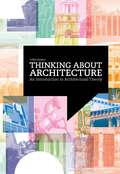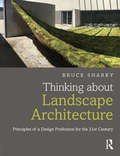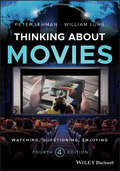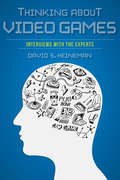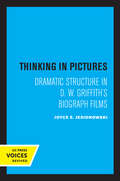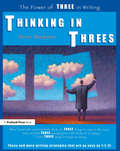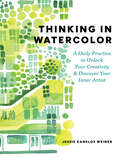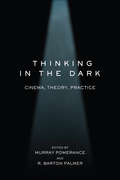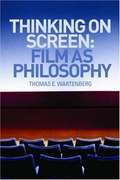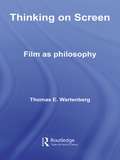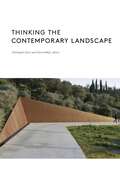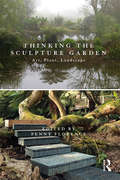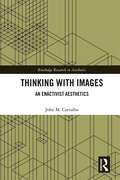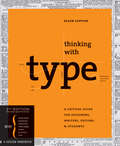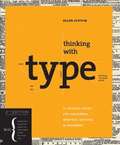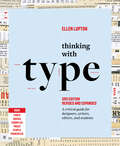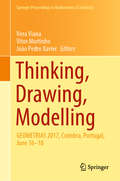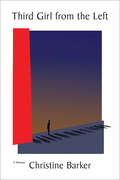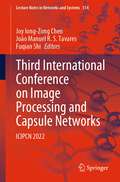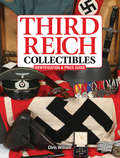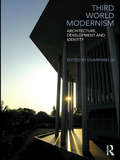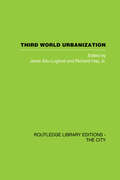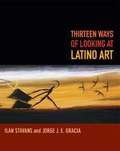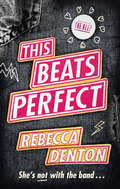- Table View
- List View
Thinking about Architecture: An Introduction To Architectural Theory
by Colin DaviesIn order to understand architecture in all its cultural complexity it is necessary to grasp such basic concepts as representation, form and space. The aim of this book is to provide teachers, students, practising architects and general readers with a set of ideas that will enrich their conversation, their writing, and above all their thinking about architecture. The book is divided into eight chapters, each covering a particular aspect of architecture, and introduces difficult concepts gradually. Architectural theorists and philosophers are mentioned in passing and their works are listed in the bibliography, but they are not the subject of the book. Architecture, rather than philosophy, is at the centre of the picture. The aim is to enable the reader to understand architecture in all its aspects, rather than to learn the names of particular theorists. Written in a conversational style, Thinking about Architecture is an invaluable and accessible standard introduction to architectural theory.
Thinking about Architecture: An Introduction to Architectural Theory
by Colin DaviesIn order to understand architecture in all its cultural complexity it is necessary to grasp such basic concepts as representation, form and space. The aim of this book is to provide teachers, students, practising architects and general readers with a set of ideas that will enrich their conversation, their writing, and above all their thinking about architecture. The book is divided into eight chapters, each covering a particular aspect of architecture, and introduces difficult concepts gradually. Architectural theorists and philosophers are mentioned in passing and their works are listed in the bibliography, but they are not the subject of the book. Architecture, rather than philosophy, is at the centre of the picture. The aim is to enable the reader to understand architecture in all its aspects, rather than to learn the names of particular theorists. Written in a conversational style, Thinking about Architecture is an invaluable and accessible standard introduction to architectural theory.
Thinking about Landscape Architecture: Principles of a Design Profession for the 21st Century
by Bruce SharkyWhat is landscape architecture? Is it gardening, or science, or art? In this book, Bruce Sharky provides a complete overview of the discipline to provide those that are new to the subject with the foundations for future study and practice. The many varieties of landscape practice are discussed with an emphasis on the significant contributions that landscape architects have made across the world in daily practice.? Written by a leading scholar and practitioner, this book outlines the subject and explores how, from a basis in garden design, it 'leapt over the garden wall' to encapsulate areas such as urban and park design, community and regional planning, habitat restoration, green infrastructure and sustainable design, and site engineering and implementation. Coverage includes: The effects that natural and human factors have upon design, and how the discipline is uniquely placed to address these challenges? Examples of contemporary landscape architecture work - from storm water management and walkable cities to well-known projects like the New York High Line and the London Olympic Park? Exploration of how art and design, science, horticulture, and construction come together in one subject? Thinking about Landscape Architecture is perfect for those wanting to better understand this fascinating subject, and those starting out as landscape architecture students.
Thinking about Movies: Watching, Questioning, Enjoying
by William Luhr Peter LehmanA complete introduction to analyzing and enjoying a wide variety of movies, for film students and movie lovers alike Thinking About Movies: Watching, Questioning, Enjoying, Fourth Edition is a thorough overview of movie analysis designed to enlighten both students and enthusiasts, and heighten their enjoyment of films. Readers will delve into the process of thinking about movies critically and analytically, and find how doing so can greatly enhance the pleasure of watching movies. Divided roughly into two parts, the book addresses film studies within the context of the dynamics of cinema, before moving on to a broader analysis of the relationship of films to the larger social, cultural, and industrial issues informing them. This updated fourth edition includes an entirely new section devoted to a complete analysis of the film adaptation of The Girl with the Dragon Tattoo, along with many in-depth discussions of important films such as Citizen Kane and Silence of the Lambs. The chapter on television integrates a major expansion distinguishing between television in the digital era of the convergence of the entertainment and technology industries in comparison to the era of broadcast analogue television. The final chapter places film within the current context of digital culture, globalization, and the powerful rise of China in film production and exhibition. The authors clearly present various methodologies for analyzing movies and illustrate them with detailed examples and images from a wide range of films from cult classics to big-budget, award-winning movies. This helps viewers see new things in movies and also better understand and explain why they like some better than others. Thinking About Movies: Watching, Questioning, Enjoying, Fourth Edition is ideal for film students immersed in the study of this important, contemporary medium and art form as well as students and readers who have never taken a class on cinema before.
Thinking about Video Games
by David S. HeinemanThe growth in popularity and complexity of video games has spurred new interest in how games are developed and in the research and technology behind them. David Heineman brings together some of the most iconic, influential, and interesting voices from across the gaming industry and asks them to weigh in on the past, present, and future of video games. Among them are legendary game designers Nolan Bushnell (Pong) and Eugene Jarvis (Defender), who talk about their history of innovations from the earliest days of the video game industry through to the present; contemporary trailblazers Kellee Santiago (Journey) and Casey Hudson (Mass Effect), who discuss contemporary relationships between those who create games and those who play them; and scholars Ian Bogost (How to Do Things With Videogames) and Edward Castronova (Exodus to the Virtual World), who discuss how to research and write about games in ways that engage a range of audiences. These experts and others offer fascinating perspectives on video games, game studies, gaming culture, and the game industry more broadly.
Thinking in Pictures: Dramatic Structure in D. W. Griffith's Biograph Films
by Joyce E. JesionowskiThis title is part of UC Press's Voices Revived program, which commemorates University of California Press’s mission to seek out and cultivate the brightest minds and give them voice, reach, and impact. Drawing on a backlist dating to 1893, Voices Revived makes high-quality, peer-reviewed scholarship accessible once again using print-on-demand technology. This title was originally published in 1987.
Thinking in Threes: The Power of Three in Writing
by Brian BackmanThis practical resource helps students see the importance of “the rules of three” in writing successful essays. The student-friendly activities in this book give students essay-writing strategies organized in easy-to-remember groups of three. The book includes many activities and games that help point out the importance of the number three in our language.With Thinking in Threes, powerful writing strategies are as easy as 1-2-3! Some of the rules of three explained in this book include:three steps for brainstorming,three “Ps” of a thesis statement,three parts of an essay,three paragraphs in the body of an essay,three ways to connect paragraphs and sentences,three types of evidence to support topic sentences,three qualities of a good example,three things to include in a quotation,three ways to hook the reader in an introduction,three ways to write fluent sentences,three ways to write successful conclusions, andthree phrases for completing a timed writing assignment.The goal of Thinking in Threes is to empower students to write great essays in your classroom!Grade 5-Adult
Thinking in Watercolor: A Daily Practice to Unlock Your Creativity & Discover Your Inner Artist
by Jessie Kanelos WeinerA 30-day masterclass in the art of using watercolor to tell your own stories. Unlike most watercolor instruction books based on rote copying of classic watercolor subjects, Thinking in Watercolor encourages readers to use art as a means of self-expression. Author and in-demand illustrator Jessie Kanelos Weiner encourages readers through foundational watercolor techniques and shows how to adapt them to share their personal experiences over the course of several days. On Day 10 they&’ll illustrate a family recipe; on Day 14 they&’ll go on a scavenger hunt through a local museum—and so forth. As both a commercial illustrator and professional art instructor, Jessie is uniquely poised to offer readers insider tips and clever visualizations of the creative process—and she brings each lesson to life with her vivid illustrations and stories from her life as an ex-pat in Paris. It all adds up to a volume that&’s at once inspiring, charming, and informative—the perfect gift for anyone looking to begin or reignite a personal art practice.
Thinking in the Dark: Cinema, Theory, Practice
by Murray Pomerance Johannes Von Moltke Daniel Morgan R. Barton Palmer Dudley Andrew Tom Conley Sarah Keller Colin Williamson Steven Rybin Steven Woodward Jeremy Blatter Professor William Rothman Tom Gunning Gilberto Perez Professor Kristen Hatch Dominic Lennard Alex Clayton Nathan Holmes Will Scheibel Jonah Corne Professor William Brown Professor Matthew SolomonToday's film scholars draw from a dizzying range of theoretical perspectives--they're just as likely to cite philosopher Gilles Deleuze as they are to quote classic film theorist André Bazin. To students first encountering them, these theoretical lenses for viewing film can seem exhilarating, but also overwhelming. Thinking in the Dark introduces readers to twenty-one key theorists whose work has made a great impact on film scholarship today, including Rudolf Arnheim, Sergei Eisenstein, Michel Foucault, Siegfried Kracauer, and Judith Butler. Rather than just discussing each theorist's ideas in the abstract, the book shows how those concepts might be applied when interpreting specific films by including an analysis of both a classic film and a contemporary one. It thus demonstrates how theory can help us better appreciate films from all eras and genres: from Hugo to Vertigo, from City Lights to Sunset Blvd., and from Young Mr. Lincoln to A.I. and Wall-E. The volume's contributors are all experts on their chosen theorist's work and, furthermore, are skilled at explaining that thinker's key ideas and terms to readers who are not yet familiar with them. Thinking in the Dark is not only a valuable resource for teachers and students of film, it's also a fun read, one that teaches us all how to view familiar films through new eyes. Theorists examined in this volume are: Rudolf Arnheim, Béla Balázs, Roland Barthes, André Bazin, Walter Benjamin, Judith Butler, Stanley Cavell, Michel Chion, Gilles Deleuze, Jean Douchet, Sergei Eisenstein, Jean Epstein, Michel Foucault, Siegfried Kracauer, Jacques Lacan, Vachel Lindsay, Christian Metz, Hugo Münsterberg, V. F. Perkins, Jacques Rancière, and Jean Rouch.
Thinking on Screen: Film as Philosophy
by Thomas E. Staff Thomas E. WartenbergThinking on Screen: Film as Philosophyis an accessible and thought-provoking examination of the way films raise and explore complex philosophical ideas. Written in a clear and engaging style, Thomas Wartenberg examines films' ability to discuss, and even criticize ideas that have intrigued and puzzled philosophers over the centuries such as the nature of personhood, the basis of morality, and epistemological skepticism. Beginning with a demonstration of how specific forms of philosophical discourse are presented cinematically, Wartenberg moves on to offer a systematic account of the ways in which specific films undertake the task of philosophy. Focusing on the films The Man Who Shot Liberty Valance, Modern Times, The Matrix, Eternal Sunshine of the Spotless Mind, The Third Man, The Flicker, and Empire, Wartenberg shows how these films express meaningful and pertinent philosophical ideas. This book is essential reading for students of philosophy with an interest in film, aesthetics, and film theory. It will also be of interest to film enthusiasts intrigued by the philosophical implications of film.
Thinking on Screen: Film as Philosophy
by Thomas E. WartenbergThinking on Screen: Film as Philosophy is an accessible and thought-provoking examination of the way films raise and explore complex philosophical ideas. Written in a clear and engaging style, Thomas Wartenberg examines films’ ability to discuss, and even criticize ideas that have intrigued and puzzled philosophers over the centuries such as the nature of personhood, the basis of morality, and epistemological skepticism. Beginning with a demonstration of how specific forms of philosophical discourse are presented cinematically, Wartenberg moves on to offer a systematic account of the ways in which specific films undertake the task of philosophy. Focusing on the films The Man Who Shot Liberty Valance, Modern Times, The Matrix, Eternal Sunshine of the Spotless Mind, The Third Man, The Flicker, and Empire, Wartenberg shows how these films express meaningful and pertinent philosophical ideas. This book is essential reading for students of philosophy with an interest in film, aesthetics, and film theory. It will also be of interest to film enthusiasts intrigued by the philosophical implications of film.
Thinking the Contemporary Landscape
by Dora Imhof Christophe GirotOn the heels of our groundbreaking books in landscape architecture, James Corner's Recovering Landscape and Charles Waldheim's Landscape Urbanism Reader, comes another essential reader, . Examining our shifting perceptions of nature and place in the context of environmental challenges and how these affect urbanism and architecture, the seventeen essayists in argue for an all-encompassing view of landscape that integrates the scientific, intellectual, aesthetic, and mythic into a new multidisciplinary understanding of the contemporary landscape. A must-read for anyone concerned about the changing nature of our landscape in a time of climate crisis.
Thinking the Sculpture Garden: Art, Plant, Landscape
by Penny FlorenceThis innovative book poses two, deceptively simple, questions: what is a sculpture garden, and what happens when you give equal weight to the main elements of landscape, planting and artwork? Its wide-ranging frame of reference, including the USA, Europe and Japan, is brought into focus through Tremenheere Sculpture Garden, Cornwall, with which the book begins and ends. Effectively less than 15 years old, and largely the work of one man, Tremenheere affords an opportunity to examine as work-in-progress the creation of a new kind of sculpture garden. Including a historical overview, the book traverses multiple ways of seeing and experiencing sculpture gardens, culminating in an exploration of their relevance as 'cultural ecology' in the context of globalisation, urbanisation and climate change. The thinking here is non-dualist and broadly aligned with New Materialisms and Material Feminisms to explore our place as humans in the non-human world on which we depend. Eminent contributors, including John Dixon Hunt, George Descombes, Bernard Lassus and David Leatherbarrow, approach these issues through practices and theories of landscape architecture; garden and art making; history and writing; and philosophy. Richly illustrated with over 100 images, including a colour plate section, the book will primarily appeal to those engaged in professional or academic research, along with sculpture garden visitors, who will find new and surprising ways of experiencing plants and art in natural and urban settings.
Thinking with Images: An Enactivist Aesthetics (Routledge Research in Aesthetics)
by John M. CarvalhoThis book advances an enactivist theory of aesthetics through the study of inscrutable artworks that challenge us to think because we do not know what to think about them. John M. Carvalho presents detailed analyses a four artworks that share this unique characteristic: Francis Bacon’s Study After Velázquez’s Portrait of Pope Innocent X (1953), the photographs of Duane Michals, based on a retrospective of his work, Storyteller, at the Carnegie Museum of Art (2014), Étant donnés (1968) by Marcel Duchamp, and Jean-Luc Godard’s 1963 film Le Mépris (released in the United States as Contempt). Carvalho argues against the application of theory to derive appreciation or meaning from these artistic works. Rather, each study enacts an embodied cognitive engagement with the specific artworks intended to demonstrate the value of thinking about artworks that might be extended to our engagement with the world in general. This thinking happens, as these studies show, when we trust our embodied skills and their guide to what artworks and the world around us afford for the activation and refinement of those skills. Thinking with Images will be of interest to scholars working in the philosophy of art and philosophical aesthetics, as well as art historians concerned with the meaning and value of contemporary art.
Thinking with Type: A Critical Guide for Designers, Writers, Editors, & Students
by Ellen Lupton"Thinking with Type is to typography what Stephen Hawking's A Brief History of Time is to physics."—I Love TypographyThe best-selling Thinking with Type in a revised and expanded second edition: Thinking with Type is the definitive guide to using typography in visual communication. Ellen Lupton provides clear and focused guidance on how letters, words, and paragraphs should be aligned, spaced, ordered, and shaped. The book covers all typography essentials, from typefaces and type families, to kerning and tracking, to using a grid. Visual examples show how to be inventive within systems of typographic form, including what the rules are, and how to break them.This revised edition includes forty-eight pages of new content with the latest information on:• style sheets for print and the web• the use of ornaments and captions• lining and non-lining numerals• the use of small caps and enlarged capitals• mixing typefaces• font formats and font licensingPlus, new eye-opening demonstrations of basic typography design with letters, helpful exercises, and dozens of additional illustrations.Thinking with Type is the typography book for everyone: designers, writers, editors, students, and anyone else who works with words. If you love font and lettering books, Ellen Lupton's guide reveals the way typefaces are constructed and how to use them most effectively.Fans of Thinking with Type will love Ellen Lupton's new book Extra Bold: A Feminist, Inclusive, Anti-racist, Nonbinary Field Guide for Graphic Designers.
Thinking with Type: A Critical Guide for Designers, Writers, Editors, and Students
by Ellen LuptonLupton (graphic design, Maryland Institute College of Art, Baltimore; Cooper-Hewitt, National Design Museum in New York) offers practical information about type within a context of design history and theory in a text that reflects the diversity of typographic life, past and present. Through three sections on letter, text, and grid, the volume begins with an exploration of the basic letter forms, and builds to the organization of words into coherent bodies and flexible systems. Each section opens with a narrative essay about the cultural and theoretical issues of typographic design across a range of media, followed by example pages demonstrating how and why typography is structured as it is. No subject index.
Thinking with Type: A Critical Guide for Designers, Writers, Editors, and Students (3rd Edition, Revised and Expanded)
by Ellen LuptonThe essential and bestselling guide to typography from beloved design educator Ellen Lupton—revised and expanded to include new and additional voices, examples, and principles, and a wider array of typefaces."Thinking with Type is to typography what Stephen Hawking's A Brief History of Time is to physics."—I Love Typography The bestselling Thinking with Type in a revised and expanded third edition: This is the definitive guide to using typography in visual communication. Covering the essentials of typography, this book explores everything from typefaces and type families to kerning and tracking to grids and layout principles.Ellen Lupton provides clear and focused guidance on how letters, words, and paragraphs should be aligned, spaced, ordered, and shaped. Historical and contemporary examples of graphic design show how to learn the rules and how to break them. Critical essays, eye-opening diagrams, helpful exercises, and dozens of examples and illustrations show readers how to be inventive within systems that inform and communicate.Featuring 32 pages of new content, the third edition is revised and refined from cover to cover:More fonts: old fonts, new fonts, weird fonts, libre fonts, Google fonts, Adobe fonts, fonts from independent foundries, and fonts and lettering by women and BIPOC designersIntroductions to diverse writing systems, contributed by expert typographers from around the worldDemonstrations of basic design principles, such as visual balance, Gestalt grouping, and responsive layoutCurrent approaches to typeface design, includingVariable fonts and optical sizesTips for readability, legibility, and accessibilityStunning reproductions from the Letterform ArchiveThinking with Type is the typography book for everyone: designers, writers, editors, students, anyone who works with words on page or screen, and enthusiasts of type and lettering. Readers will also love Ellen Lupton's book Extra Bold: A Feminist, Inclusive, Anti-racist, Nonbinary Field Guide for Graphic Designers.
Thinking, Drawing, Modelling: GEOMETRIAS 2017, Coimbra, Portugal, June 16–18 (Springer Proceedings in Mathematics & Statistics #326)
by Vera Viana Vítor Murtinho João Pedro XavierThis book presents a selection of papers from the International Conference Geometrias’17, which was hosted by the Department of Architecture at the University of Coimbra from 16 to 18 June 2017. The Geometrias conferences, organized by Aproged (the Portuguese Geometry and Drawing Teachers’ Association), foster debate and exchange on practical and theoretical research in mathematics, architecture, the arts, engineering, and related fields.Geometrias’17, with the leitmotif “Thinking, Drawing, Modelling”, brought together a group of recognized experts to discuss the importance of geometric literacy and the science of representation for the development of scientific and technological research and professional practices. The 12 peer-reviewed papers gathered here show how geometry, drawing, stereotomy, and the science of representation are still at the core of every act leading to the conception and materialization of form, and highlight their continuing relevance for scholars and professionals in the fields of architecture, engineering, and applied mathematics.
Third Girl from the Left
by Christine Barker&“A beautifully written memoir of life on the Broadway stage at the onset of the 1980s AIDS epidemic . . . Compelling, and remarkably hopeful.&” —Mara Liasson, National Political Correspondent, NPR A moving, real-life account of making it as a dancer in New York City, embracing the changing faces of love and family, and being at ground-zero for one of the most fatal epidemics of modern times . . . Wanting to be a dancer while growing up in a large military family made Christine Barker somewhat of a black sheep, but she followed her dreams to New York City, where—in a moment of almost unbelievable good fortune—she was chosen for the London cast of A Chorus Line. London, and then New York, in the seventies and eighties opened up Christine&’s world. The creativity, culture, and nightlife were intoxicating, enough so to compel her older brother Laughlin to join her. Once there, the divorced father, veteran, and corporate lawyer met rising fashion star Perry Ellis. Romance and success soon followed—as well as rumors of a devastating new disease . . . Broadway&’s theater community is ravaged by loss as the AIDS epidemic takes hold, and Christine is shocked by the toll it&’s taken on her inner circle. Holding on tight to friends and loved ones left behind, the crisis becomes a crucible moment for her family and for all of society. And Christine is once again forced to go her own way to make sense of the tragedy.
Third International Conference on Image Processing and Capsule Networks: ICIPCN 2022 (Lecture Notes in Networks and Systems #514)
by João Manuel R. S. Tavares Joy Iong-Zong Chen Fuqian ShiThis book provides a collection of the state-of-the-art research attempts to tackle the challenges in image and signal processing from various novel and potential research perspectives. The book investigates feature extraction techniques, image enhancement methods, reconstruction models, object detection methods, recommendation models, deep and temporal feature analysis, intelligent decision support systems, and autonomous image detection models. In addition to this, the book also looks into the potential opportunities to monitor and control the global pandemic situations. Image processing technology has progressed significantly in recent years, and it has been commercialized worldwide to provide superior performance with enhanced computer/machine vision, video processing, and pattern recognition capabilities. Meanwhile, machine learning systems like CNN and CapsNet get popular to provide better model hierarchical relationships and attempts to more closely mimic biological neural organization. As machine learning systems prosper, image processing and machine learning techniques will be tightly intertwined and continuously promote each other in real-world settings. Adopting this trend, however, the image processing researchers are faced with few image reconstruction, analysis, and segmentation challenges. On the application side, the orientation of the image features and noise removal has become a huge burden.
Third Reich Collectibles: Identification and Price Guide
by Chris WilliamThe rise and fall of Germany's Third Reich is one of the most studied, investigated and collected episodes of military history. A reign of terror that rose to near world domination during the 1930s and early 1940s, Adolph Hitler's Germany continues to fascinate generations of scholars and students of history alike.The Third Reich's insatiable drumbeat of pageantry and propaganda produced countless uniforms, insignia, medals, flags, daggers, swords, and headgear, comprising one of the most desired categories in all of military collectibles to study, understand and own.Groundbreaking in scope and execution, Third Reich Collectibles features more than 1,300 color images with descriptions and values for:UniformsHelmetsHeadgearFlagsBadgesMembership pinsPatchesArmbandsFirearmsBladesEquipmentPaper IDsSignageAnd more associated with the military and paramilitary groups of the Third ReichThroughout the book you'll also find historical background information and period photographs capturing everyday Nazi Germany.
Third World Modernism: Architecture, Development and Identity
by Duanfang LuThis set of essays brings together studies that challenge interpretations of the development of modernist architecture in Third World countries during the Cold War. The topics look at modernism’s part in the transnational development of building technologies and the construction of national and cultural identity. Architectural modernism is far more than another instance of Western expansionist aspirations; it has been developed in cross-cultural spaces and variously localized into nation-building programs and social welfare projects. The first volume to address countries right across the developing world, this book has a key place in the historiography of modern architecture, dealing with non-Western traditions.
Third World Urbanization
by J. Abu-Lughod R. Jr HayFirst published in 2006. Routledge is an imprint of Taylor & Francis, an informa company.
Thirteen Ways of Looking at Latino Art
by Ilan Stavans Jorge J. GraciaThe essayist and cultural commentator Ilan Stavans and the analytic philosopher Jorge J. E. Gracia share long-standing interests in the intersection of art and ideas. Here they take thirteen pieces of Latino art, each reproduced in color, as occasions for thematic discussions. Whether the work at the center of a particular conversation is a triptych created by the brothers Einar and Jamex de la Torre, Andres Serrano's controversial Piss Christ, a mural by the graffiti artist BEAR_TCK, or Above All Things, a photograph by María Magdalena Campos-Pons, Stavans and Gracia's exchanges inevitably open out to literature, history, ethics, politics, religion, and visual culture more broadly. Autobiographical details pepper Stavans and Gracia's conversations, as one or the other tells what he finds meaningful in a given work. Sparkling with insight, their exchanges allow the reader to eavesdrop on two celebrated intellectuals--worldly, erudite, and unafraid to disagree--as they reflect on the pleasures of seeing.
This Beats Perfect (This Beats Perfect #1)
by Rebecca Denton'This Beats Perfect is a fabulous celebration of music, friendship, and following your dreams' Katherine Webber, author of Wing JonesAmelie Ayres has impeccable taste in music. Bowie. Bush. Bob. So when she finds herself backstage at The Keep's only UK gig she expects to hate it; after all they are the world's most tragic band. In fact she feels a grudging respect - not (obviously) for their music, but for the work that goes in to making them megastars. And when lead singer, 'Maxx', is not dressed up as a cross between Elvis and a My Little Pony, he is actually rather normal, talented and has creative struggles not too dissimilar to her own. But the next morning she wakes up and rolls over to discover a million new @'s on social media. Overnight, a photo of her at the gig has made her a subject of global speculation. Suddenly the world needs to know #Who'sThatGirl? - but for all the wrong reasons.All Amelie wants is to play her music. She's got the guitar, the songs, the soul and, in the safety of her bedroom, she's got the voice. But when it comes to getting up on stage, she struggles with self-doubt.Immaculate's a concept. Flawless is fake. But just sometimes music - and hearts - can rock a perfect beat.'A witty exploration into the world of celebrity' The Sun
